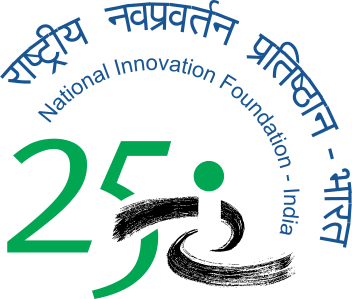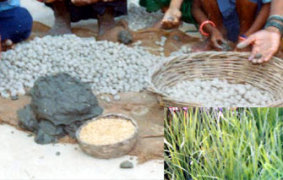Innovative Technique of Using Clay Pellets for Sowing Paddy
Ram Abhilash Patel (48) is a resident of Jasra, Allahabad. He studied upto the intermediate and spent all his childhood in the village involved in agriculture, which is his family occupation. He has his own farmland in Jasra where he pursues his farming activities. Patel is quite Internet savvy and has an e-chaupal installed in his house. He lives with his parents, his wife and children (two sons and a daughter). Ram Abhilash also has plans to devise a mechanism to use Gobar gas instead of the normal LPG in gas cylinders for preparing food.
Genesis
Ram Abhilash got the idea of this method from within the household. He noticed that when children made clay pellets just for fun, they start germinating in the rainy season. This inspired him. He faced a lot of problems in finding the right kind of soil namely clay for this method. This was required because other soils break under pressure, while he had to ensure that the pellets remain as such during sowing and germination. But his family backed him right throughout the innovation. This method has been tried and tested in his land in the village. He has been practising this technique since 1994 and some more farmers (around 10) in his neighbourhood have also started practicing the same. He plans to start a business using this method if some financial help is provided.
The crop production of paddy depends on the way the plants are sown. Ram Abhilash Patel has developed an innovative way of sowing paddy using clay pellets.
In this method, pellets (mixture of pond soil and paddy seeds) are prepared and these pellets are ready for sowing after drying. The pond or river soil is taken and mixed thoroughly with paddy seeds. When the mixture is ready, then small pellets are prepared with each containing 3-4 seeds. The pellets can only be prepared in the month of April and May so that they dry within 2-3 hours; otherwise if it takes more time for drying then there is a risk of the seeds getting germinated and thus getting spoiled. Pond soil is used as it is very fertile and helps in minimizing weeds. These pellets can be sown manually or with the help of a seed drill but manual practice is followed, as seed drills are not available for this size of pellets. Rows are made facing east to west or vice-versa so the plant will get ample air and sunlight. Normally in a family these pellets are prepared by women and children and after drying these can be stored for about a month.
Advantages
This novel method saves both time and money. There is no need to prepare a nursery for paddy plants. By using the nursery method, the crop takes approximately 160 days to mature while using this technique it takes about 145 days. With this method farmers need not wait for monsoon to start sowing. As pond/ river soil which is very fertile is used to prepare the pellets the use of fertilizers is minimized. As the seeds are in a mud shell they are protected from birds etc. The process also saves water as no standing water is needed in the field. Most importantly the output is maximized by this method, which Ram Abhilash has proved experimentally by cultivating paddy in a field by all three methods namely pellet, nursery and direct sowing. The paddy production using these methods was 17 quintals, 15 quintals and 14 quintals respectively.








